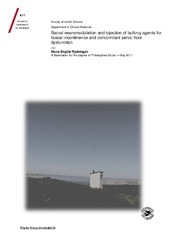Sacral neuromodulation and injection of bulking agents for faecal incontinence and concomitant pelvic floor dysfunction
Permanent lenke
https://hdl.handle.net/10037/11077Åpne
Dato
2017-05-12Type
Doctoral thesisDoktorgradsavhandling
Forfatter
Rydningen, Mona BirgitteSammendrag
Method: Consecutive women with severe FI following OASIS after failure of conservative treatment were eligible. All women went through a three-week percutaneous nerve evaluation (PNE) period. The women with a successful PNE, defined as 50 % reduction of weekly FI episodes, were randomly assigned to SNM or Permacol®(1:1). After 6 months, cross over to the other treatment arm were allowed. Baseline factors related to PNE outcome is discussed in paper I. The changes from baseline to 6 months between the SNM group and Permacol® group are analysed in paper II. Outcomes were evaluated with questionnaires for FI (St Mark’s score, bowel habit diary), Quality of life (QoL), (Rockwood FIQL, EQ-5D), urinary incontinence (UI) (ICIQ-UI-SF) and sexual function (RooS). The outcome after SNM in women with combined FI and UI (double incontinence, DI) is explored in paper III. Main results Fifty-six of the 63 (89%) women had a successful PNE. Efficacy was related to concomitant UI (p=0.046) and body mass index (BMI) (p=0.03). Pain during PNE was related to unsuccessful outcome (p=0.046). The extent of sphincter defect was unrelated to efficacy (p= 0.1). The reduction in the St. Mark’s score between baseline and 6 months was 11.2 (SD 5.3) in the SNM group (n=30) versus 2.3 (SD 5.0) in the Permacol® group (n=26), resulting in a difference of 8.9 (95% CI 6.1-11.7, p<0.0001) in favour of SNM. UI ceased in 13 (33%) and weekly FI episodes disappeared in 23 (62%) of the 37 women treated with SNM for DI. The reduction in ICIQ-UI-SF score was 5.8 (95% CI 3.7-8.0, p<0.001) and in the St Mark’s score was 10.6 (95% CI 8.6-12.7, p<0.001).
Conclusion: SNM was superior to Permacol® in terms of change in St Mark’s score and disease specific QoL. Concomitant UI was successfully treated with SNM in the majority of the women with DI. Outcome was not related to the extent of a pre-existing sphincter defect.
Beskrivelse
Paper III: Rydningen, M. B., Riise, S., Wilsgaard, T., Lindsethmo, R. O., Norderval, S.: "Sacral neuromodulation for faecal and concomitant urinary incontinence following obstetric anal sphincter injury". (Manuscript).
Forlag
UiT The Arctic University of NorwayUiT Norges arktiske universitet
Metadata
Vis full innførselSamlinger
Følgende lisensfil er knyttet til denne innførselen:


 English
English norsk
norsk
